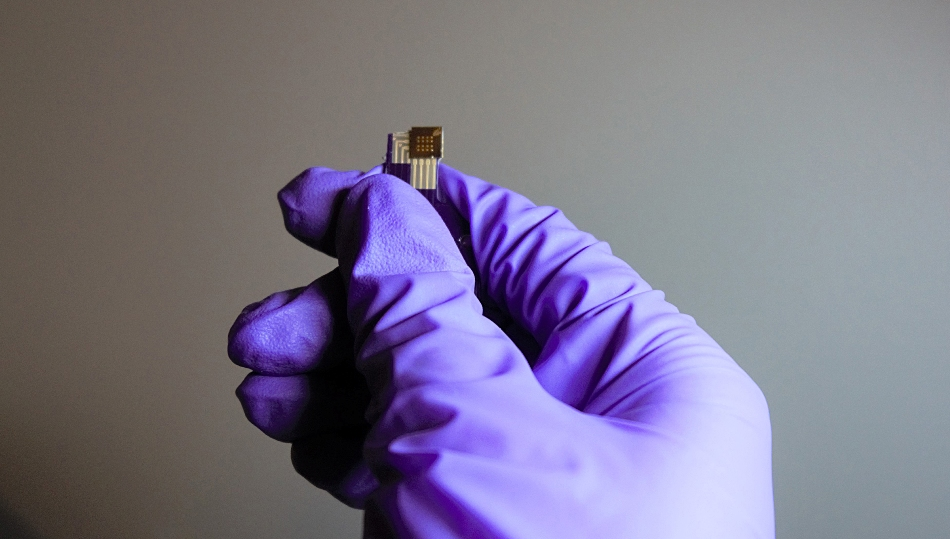May 8 2020
Artificial intelligence can necessitate software running on numerous computers to merely play a game or solve a puzzle. The energy used could be equivalent to the energy produced by three nuclear plants in an hour.
 Researchers have developed new hardware for artificial intelligence. Image Credit: Purdue University image/Qi Wang.
Researchers have developed new hardware for artificial intelligence. Image Credit: Purdue University image/Qi Wang.
A group of engineers has developed hardware with the ability to learn skills using a kind of AI that currently runs on software platforms. If intelligence features are shared between software and hardware, the energy required to use AI in more sophisticated applications, like self-driving cars or discovering drugs, would be offset.
Software is taking on most of the challenges in AI. If you could incorporate intelligence into the circuit components in addition to what is happening in software, you could do things that simply cannot be done today.
Shriram Ramanathan, Professor of Materials Engineering, Purdue University
Developing hardware for AI is still in its early stages. Although researchers have been able to demonstrate AI in pieces of prospective hardware, they have not yet met AI’s huge energy demand.
With AI penetrating more into the everyday life of humans, heavy dependence on software with huge energy demands is not sustainable, added Ramanathan. If software and hardware could share intelligence features, a portion of silicon might be able to realize more with specified energy input.
Ramanathan’s group is the first to show artificial “tree-like” memory in a piece of prospective hardware at room temperature. In the past, researchers have only been able to notice this type of memory in hardware at temperatures too low for electronic devices. The study outcomes were reported in the Nature Communications journal.
The hardware developed by Ramanathan’s team is made of what is called a quantum material—materials known to exhibit properties that cannot be characterized by classical physics.
Ramanathan’s lab has been attempting to gain better insights into these materials and how they could be employed to solve problems in electronics. Software makes use of tree-like memory to arrange information into different “branches,” rendering the information easier to extract while learning new tasks or skills.
The approach is based on how the human brain classifies information and makes decisions.
Humans memorize things in a tree structure of categories. We memorize ‘apple’ under the category of ‘fruit’ and ‘elephant’ under the category of ‘animal,’ for example. Mimicking these features in hardware is potentially interesting for brain-inspired computing.
Hai-Tian Zhang, Lillian Gilbreth Postdoctoral Fellow, College of Engineering, Purdue University
A proton was introduced into neodymium nickel oxide, a quantum material. It was found that an electric pulse applied to the material tends to move around the proton. Each new position of the proton forms a distinct resistance state, thus creating an information storage site known as a memory state. Multiple electric pulses form a branch composed of memory states.
“We can build up many thousands of memory states in the material by taking advantage of quantum mechanical effects. The material stays the same. We are simply shuffling around protons,” added Ramanathan.
The researchers simulated the properties found in this material and demonstrated that the material can learn the numbers 0 to 9. The ability to learn numbers is a baseline test of artificial intelligence.
Demonstrating these trees in a material at room temperature could help demonstrate the ability of the hardware to offload tasks from software.
This discovery opens up new frontiers for AI that have been largely ignored because implementing this kind of intelligence into electronic hardware didn’t exist.
Shriram Ramanathan, Professor of Materials Engineering, Purdue University
Using the material, researchers might also create a platform for humans to communicate with AI more naturally.
“Protons also are natural information transporters in human beings. A device enabled by proton transport may be a key component for eventually achieving direct communication with organisms, such as through a brain implant,” stated Zhang.
The quantum material test strips were investigated by researchers at the University of California, San Diego. The research group used synchrotron facilities at the U.S. Department of Energy’s Brookhaven and Argonne National Laboratories to show that an electric pulse can move protons inside neodymium nickel oxide.
The University of Illinois, the University of Louisville, and the University of Iowa are the other collaborating institutions. The study was supported by the Lillian Gilbreth Fellowship from Purdue University’s College of Engineering, the Air Force Office of Scientific Research, and the U.S. Department of Energy.
Journal Reference:
Zhang, H.-T., et al. (2020) Perovskite neural trees. Nature Communications. doi.org/10.1038/s41467-020-16105-y.